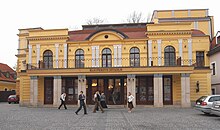Klicpera Theater
The Klicpera Theater ( Klicperovo divadlo in Czech or Klicperovo for short ) in Hradec Králové is the main theater of the city and its region. It is housed in a 19th century building that is located within the historic old town. This theater was named after the Bohemian writer and playwright Václav Kliment Klicpera .
location
The Klicpera Theater has its headquarters and main venue in a complex that consists of a two-story main building with an attached stage. In front of the theater there is a plaza-like widening on Long Street (Dlouhá), which opens into Klicperova on the opposite side.
building
The main building, which mainly houses the entrance and the theater foyer , has a facade with elements of the neo-Renaissance style . The immediate entrance area was redesigned around 1990 and has a wide roof. Božanov sandstone and Opuka were used. This roofing results in a large balcony area on the first floor.
The auditorium has 407 seats. The stage has an area of 8 × 7 meters. The height of the stage space is limited to 5.4 meters.
The historic building of today's theater was built between 1844 and 1845 according to plans by Viktor Weinhengst . Before it was built, there was a military hospital of the Imperial Austrian Army at the time. Until the beginning of the theater function, the fortress headquarters was located in this building.
The inauguration of the theater took place in March 1885. Shortly afterwards, a part of the building at the back collapsed due to structural defects. After repairing the damage, the theater was ceremoniously reopened in November 1887.
theatre
The Klicpera Theater is the only one of its kind with full-time staff in the Hradec Králové region . It thus has a central theater-cultural position for the northeastern Bohemia region. In addition to domestic activities at its headquarters, the artistic staff also perform playing duties in other Czech locations and abroad. Game operations are supported by the Alfred Radok Foundation ( Nadace Alfreda Radoka ).
The modern repertoire includes works by domestic and foreign artists. These include Karel Čapek , Arnošt Goldflam , Mark Twain and Nikolai Gogol . In Hradec Králové there are three more stages in the main building. These are the Studio Beseda with 130 seats, the Scéna V with 50 seats and an open-air area with 300 seats.
Temporary exhibitions of modern art are held in the foyer and the entrance hall of the theater. To date (mid-2009) 112 exhibitions by 92 artists have been shown.
The theater feels particularly connected to the Czech national movement in the history of the people. The former city of Königgrätz was a center of intellectual Czechoslovakia in the 19th century. In addition to the literary activities of Jan Hostivít Pospíšil and public grammatical exercises in the Bohemian national language by Josef František Rautenkranz , dramas by Václav Kliment Klicpera were played particularly often. The aim was to give the young candidate priests from the Jesuit college additional cultural and linguistic tools for the national rebirth .
literature
- Joachim Bahlke, Winfried Eberhard, Miloslav Polívka (eds.): Handbook of historical places . Bohemia and Moravia . Stuttgart (Alfred Kröner Verlag) 1998, ISBN 3-520-32901-8
- Petr David, Vladimír Soukup, Jan Jakl, Marek Pavlík (translation by Oliver Groschner): Travel guide through Bohemia, Moravia, Silesia. Hradec Králové . Prague (Soukup & David publishing house) 1997 ISBN 80-86050-12-2
Web links
- Official site (Czech text)
Coordinates: 50 ° 12 '39.2 " N , 15 ° 50' 1.9" E

